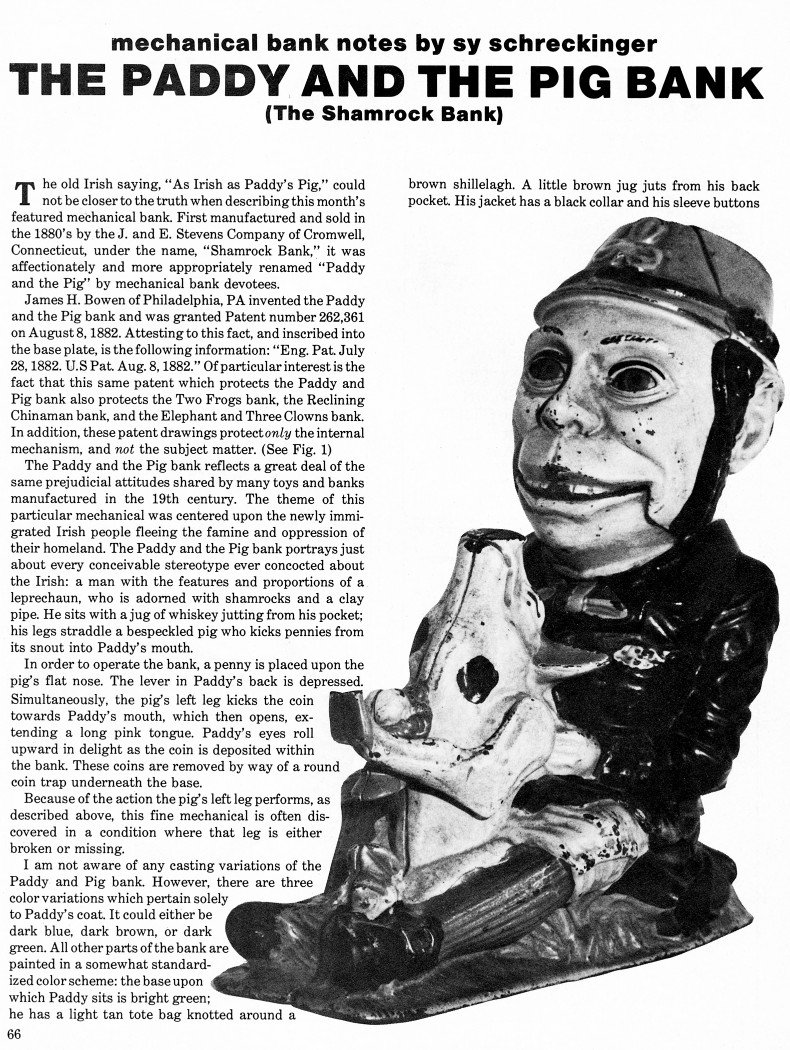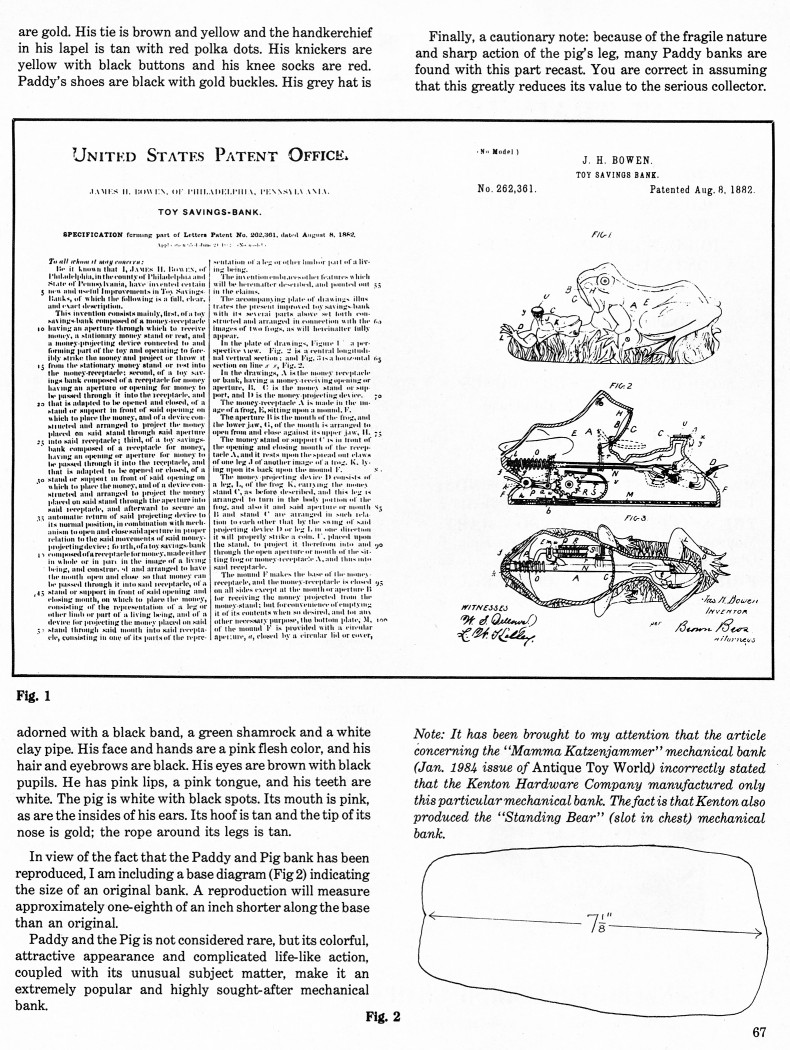|
The Paddy and the Pig
Bank
(The Shamrock Bank)
by Sy Schreckinger – ANTIQUE TOY WORLD Magazine – March, 1984
The old Irish saying, "As Irish as
Paddy's Pig," could not be closer to the truth when describing this
month's featured mechanical bank. First manufactured and sold in the
1880's by the J. and E. Stevens Company of Cromwell, Connecticut, under
the name, "Shamrock Bank," it was affectionately and more appropriately
renamed "Paddy and the Pig" by mechanical bank devotees.
James H. Bowen of Philadelphia, PA invented the Paddy and the Pig
bank and was granted Patent number
262,361 on August 8, 1882. Attesting to
this fact, and inscribed into the base plate, is the following
information: "Eng. Pat. July 28,1882. U. S Pat. Aug. 8, 1882." Of
particular interest is the fact that this same patent which protects the
Paddy and Pig bank also protects the Two Frogs bank, the Reclining
Chinaman bank, and the Elephant and Three Clowns bank. In addition, these
patent drawings protect only the internal mechanism, and not the subject
matter. (See Fig. 1)
The Paddy and the Pig bank reflects a great deal of the same
prejudicial attitudes shared by many toys and banks manufactured in the
19th century. The theme of this particular mechanical was centered upon
the newly immigrated Irish people fleeing the famine and oppression of
their homeland. The Paddy and the Pig bank portrays just about every
conceivable stereotype ever concocted about the Irish: a man with the
features and proportions of a leprechaun, who is adorned with shamrocks
and a clay pipe. He sits with a jug of whiskey jutting from his pocket;
his legs straddle a bespeckled pig who kicks pennies from its snout into
Paddy's mouth.
In order to operate the bank, a penny is placed upon the pig's flat
nose. The lever in Paddy's back is depressed. Simultaneously, the pig's
left leg kicks the coin towards Paddy's mouth, which then opens, extending
a long pink tongue. Paddy's eyes roll upward in delight as the coin is
deposited within the bank. These coins are removed by way of a round coin
trap underneath the base.
Because of the action the pig's left leg performs, as described
above, this fine mechanical is often discovered in a condition where that
leg is either broken or missing.
I am not aware of any casting variations of the Paddy and Pig bank.
However, there are three color variations which pertain solely to Paddy's
coat. It could either be dark blue, dark brown, or dark green. All other
parts of the bank are painted in a somewhat standardized color scheme: the
base upon which Paddy sits is bright green; he has a light tan tote bag
knotted around a brown shillelagh. A little brown jug juts from his back
pocket. His jacket has a black collar and his sleeve buttons are gold. His
tie is brown and yellow and the handkerchief in his lapel is tan with red
polka dots. His knickers are yellow with black buttons and his knee socks
are red. Paddy's shoes are black with gold buckles. His grey hat is
adorned with a black band, a green shamrock and a white clay pipe. His
face and hands are a pink flesh color, and his hair and eyebrows are
black. His eyes are brown with black pupils. He has pink lips, a pink
tongue, and his teeth are white. The pig is white with black spots. Its
mouth is pink, as are the insides of his ears. Its hoof is tan and the tip
of its nose is gold; the rope around its legs is tan.
In view of the fact that the Paddy and Pig bank has been reproduced,
I am including a base diagram (Fig 2) indicating the size of an original
bank. A reproduction will measure approximately one-eighth of an inch
shorter along the base than an original.
Paddy and the Pig is not considered rare, but its colorful,
attractive appearance and complicated life-like action, coupled with its
unusual subject matter, make it an extremely popular and highly
sought-after mechanical bank.
Finally, a cautionary note: because of the fragile nature and sharp
action of the pig's leg, many Paddy banks are found with this part recast.
You are correct in assuming that this greatly reduces its value to the
serious collector.
Note: It has been brought to my attention that the article concerning
the "Mamma Katzenjammer" mechanical bank (Jan. 1984 issue of Antique Toy
World) incorrectly stated that the Kenton Hardware Company manufactured
only this particular mechanical bank. The fact is that Kenton also
produced the "Standing Bear" (slot in chest) mechanical bank.
|


